Last updated: 31 December 2003
|
Last updated: 31 December 2003 |
This page documents Canon digital cameras comments, tips, and photos. Search the site for "canon" for other items about the Canon digital cameras. Contributions welcome.
Subject: My first Sky Sent: Sunday, November 18, 2001 3:01:53 From: Briguy730@msn.com (Brian Gaines) This one my first time every seeing a meteor...\...it is supposed to be spectacular...i am using a cannon power shot g2 camera and 15 seconds long...400 speed film...f2 tell me what u think of it...i caught the tail end of a meteor...it took many shots just to get one

Mike here: I adjusted the "levels" a little bit to darken the sky and make the meteor slightly more prominent.
Subject: MoonEtx70pics Sent: Tuesday, January 1, 2002 5:05:45 From: mattcoles72@hotmail.com (Matt Coles) Here's a pic I took in Center Parcs trying out the flexi-focus(It's Really good)I just stick the Canon Powershot A5 digital camera down the eyepiece( 3x Barlow and a 9mm MA = 117x)This is with the ETX 70AT. Please could you also tell me what F/6.3 or f/10 or all that means please?

Subject: moonshot Sent: Sunday, January 20, 2002 12:55:27 From: bottler1@eircom.net (William Hetherington) I just found your site lately and decided to try a shot myself, this was taken one morning by holding a canon ixus to one eyepiece of my binoculars, after this I think I will try some more , thank you very much for giving me another hobby, William Hetherington.

Subject: The Moon Sent: Friday, January 25, 2002 15:48:36 From: artt@crosslink.net (art thomas) Have been reading your great site for quite some time...keep up the good work. Bought myself a Canon A20 this past Christmas to go with me ETX-125. Here is my first attemp at astrophotography. Canon A20, ETX-125, Meade 40mm Super Plossl, ScopeTronix Digi-T adaptor, touched up a bit in PhotoShop with unsharp mask. art thomas

Subject: Moon and Saturn Pic Sent: Saturday, January 26, 2002 12:26:14 From: eden@research.haifa.ac.il (Eden Orion) Two days ago I there was a close encounter between Moon an Saturn. Here is a pict that I have taken with my ETX 90 EC/ 26 MM Eyepiece and my Olympus C2040 digital zoom camera It was still afternoon so Saturns is a bit dimmed Enjoy Life Eden

Subject: First try - - Believe it or not? Sent: Thursday, March 28, 2002 19:51:07 From: stephenj@io.com (SJL) Stephen Laurent here - Dripping Springs, Texas (it's 30m west of Austin). Thank you so much for your site. It has really helped me learn a lot about my ETX/125 and about photographing the skys with it. Many may not believe it but this shot of the moon was taken with my Canon Elf Digital s100 camera - Hand held through my stock 26mm eyepiece. I was amazed at the results and have many GREAT shots from the past few nights. I did do some "darkroom" work on it in Corel Photo Paint. The only work done in this one was contrast, glare reduction, and corrective filtering. Nothing has been added or taken away - no "tricks" - all could have been achieved through the use of filters at the time of the shoot. I am a digital artist and I am working on a series of altered images - Color filters, negative reversal and multiple layering of images - Would be glad to share some of those too if you are interested. For now just wanted to send you this shot as thanks for all the help your sight has given me and for the joy my scope now brings me armed with your information. I am very happy with the results as this was my first attempt and I got the shot I was looking for to use in my project. Thanks again Stephen
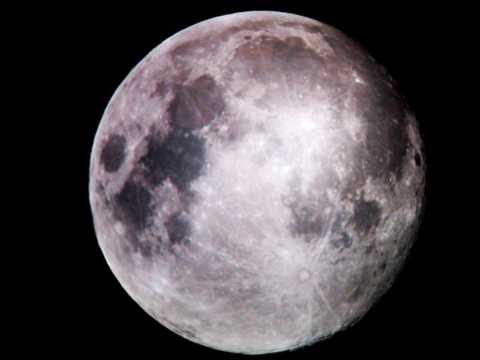
Subject: canon astrophotos Sent: Tuesday, November 12, 2002 14:15:48 From: mew180@psu.edu (marcus) I noticed that the Canon astrophotos page hasn't seen anything in a while, so I thought I'd toss these your way. Both images were taken with a Powershot S200 @ 15seconds each( it can't do longer exposures). I just sat it on a mini-tripod and let it go. No processing was done except for darkening the background a bit to make the prominent stars stand out. The object in the bottom left of the "teapot" asterism picture is an American Flag that happened to be in the shot. I was impressed that if you view the picture at the 1:1 scale, the camera resolved the double star in the handle of the big dipper. I know they aren't anything special, but its the best I can do so far....its VERY cloudy ALL the time here in Erie, PA. Keep up the great site! Marcus


Subject: Moon image from November 2002-11-24 (01:10 UT) Sent: Sunday, November 24, 2002 15:22:25 From: oldwexi@aon.at (Gerald Wechselberger) Please find attached a new image of the moon made with my ETX125EC and Canon G1 Digitalcamera. This time seeing was pretty good. Exposure 1/20 Second, Eyepiece Meade 26mm, Image overworked with Adobe Photoshop. Feel free to use this image to put it on to your Mighty ETX site. Thanks for your support of all ETX users worldwide ! Best Regards - ALOHA - Mit freundlichen Gren Gerald Wechselberger

Subject: Recent image of M42 for posting on your web site Sent: Monday, December 2, 2002 18:02:13 From: rsimon@nrao.edu (Richard Simon) I have my ETX-125EC for almost a month, and have had good luck with astrophotography. The attached image of M42 was taken with the following: - ETX-125EC (with UHTC) - Scopetronix Maxview 40mm eyepiece - Canon G2 coupled afocally (ISO 400, f/2.2, FL=12.5mm) - The camera was set to "Daylight" color balance, low contrast, low sharpness, normal color. - 10 separate 15 second exposures - Images added using astrostack, adding the R, G, amd B channels separately, then combining the 3 sums to produce the final image. - The telescope was carefully polar aligned, and only the RA drive was in use. - Some adjustment of brightness and contrast was done to the final combined image. My critique: focus, focus, focus! I think this setup could resolve the Trapezium if the focus were perfect, and fainter stas would appear. Making a 3-way "Hartman" mask for focusing is on my to-do list. As far as tracking: my scope was "supercharged" by Clay Sherrod, and the extra weight of the camera was helping the scope to move in the right direction (the RA motor didn't have to lift the camera). I was running on a fresh 12V battery. There were three other exposures which had smeared which I did not include with the 10 good exposures. The Canon does its own noise correction, so I didn't do any of my own. It was 26 degrees F outside, which may have helped reduce the noise of the CCD. Thanks to everyone on this web site for the many useful hints! Richard Simon
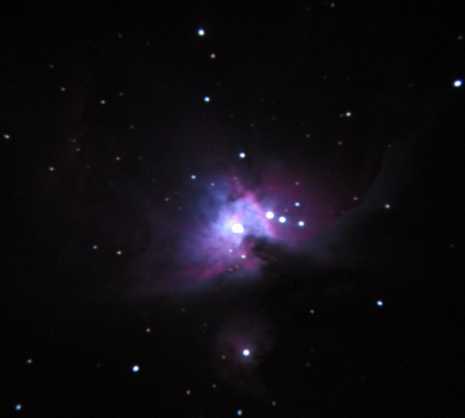
Subject: Canon G2 Astrography Sent: Wednesday, December 18, 2002 0:27:58 From: frank.stefani@ead-systeme.de (Frank Stefani) I discovered your astrophotography site recently and was very happy to find people sharing their insight. Thank you Mike and thanks to all contributors :-) Currently, I have no telescope but I did some night sky shots last week with my Canon G2 and the new 2x tele converter from Soligor. I attach two photos which you may publish if desired: The first is the original image taken with the G2 and 2x converter at f=2.8/15sec. I reduced it in size to 25 percent, because the stars turned to stripes due to earth rotation. The main step was image processing afterwords. Basically, I reduced noise from the original image and thus darkened it. Then I added the same image 5 times to make low magnitude stars visible. The last step was a slight sharpening and contrast enhancement. The second image shows the result. Be shure tue tune your monitor contrast and brightness to view stars down to magnitude 8. Image processing was done on a Linux PC with Gimp. Best wishes from the German Alps, Frank Email: ikarus@climbing.de


Subject: astrophotography Sent: Friday, December 20, 2002 20:35:08 From: genefinder@rcn.com (Brian Moldover) Equipment is a Meade DS-90ec telescope, 40mm Scoptronix MaxView eyepiece, Scopetronix camera adapter, Canon G2 digital camera. This is my first attempt at astrophotography. I'm having a difficult time determining optimal focus. I'm trying to use the little LCD screen on the back of the camera and at night it's really difficult to see. It's not a problem with a bright object like the moon, but the planets and stars are impossible to focus in this way. What do other people do to ensure they are in focus? Not sure you'd have the answer, but if someone out there does email me at genefinder@rcn.com.


Subject: Tip Sent: Monday, December 23, 2002 7:54:07 From: joerodricks@attbi.com (Joe Rodricks) I figure you can put the picture in your astrophotography section, under Canon The shot is a moon rise over the stadium lights at Gillette Stadium in Foxboro, MA, dungin the Patriots vs Jets game on 12/22/02. I used my Canon S200 fully automatic except that I limated white exposure to -2 (which is a camera built in feature)
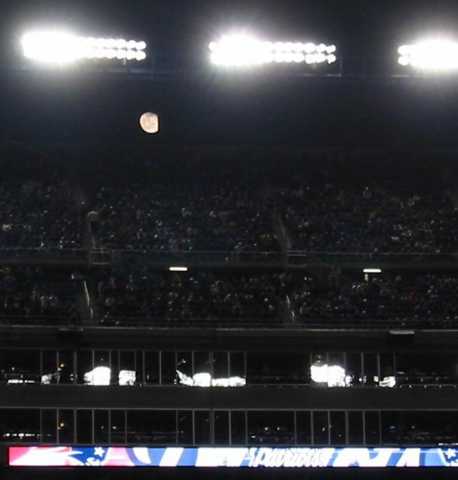
Subject: Second shot (Southern Celestial Pole) Sent: Sunday, January 19, 2003 17:30:46 From: kburfitt@bigpond.net.au (Kevin Burfitt) Here's another startrail shot I took last night of the Southern Celestial Pole Taken with a Canon G2 digital camera, 30 x 15 second exposures over 25 minutes out my back door in suburban Melbourne, AustraliaHere's a startrail shot I took last night of the Southern Celestial Pole Taken with a Canon G2 digital camera, 50 x 15 second exposures over 40 minutes out my back door in suburban Melbourne, Australia 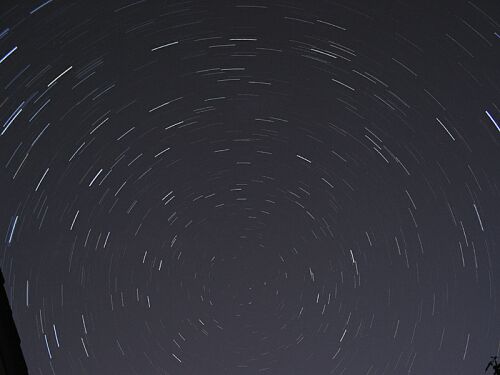
Visibility here is down to a few hundred meters right now (1pm in the afternoon, middle of summer) because of all the smoke from the bushfires around the state - I was pretty lucky that it was a clear last night! -- Kevin 'Zaph' Burfitt - Cthugha, StarLego, and more zaph@torps.com http://www.torps.com 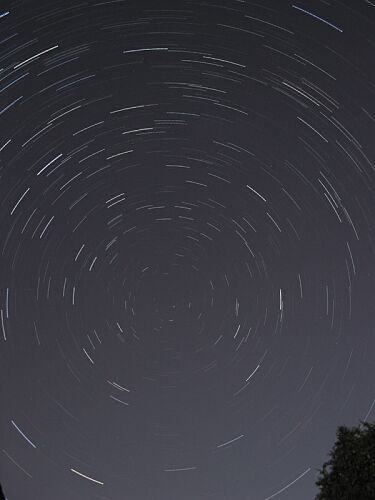
Subject: picture Sent: Tuesday, January 21, 2003 10:17:52 From: anssi.mantykivi@mail.suomi.net (Anssi Mntykivi) Moon 14.12.2002 Meade etx-70at Plossl 6mm+2xBarlow Canon Powershot s30 Unsharp Mask Photoshop 7 Anssi Mantykivi Muhos Finland

Subject: Moon Pics Sent: Friday, February 14, 2003 4:24:02 From: blakwing42@attbi.com (Steve Davlantis) I love your site! It's was a HUUGE help to my wife who purcheased a ETX125-EC for me for X-mas. This is my first scope and I'm trying to learn all I can about how to properly use it. I just need to get a tripod now and I'll be set! At any rate I'd like to include a few moon pics I've taken.. My first Astro shots ever. I used the ETX 125 with the standard 26mm Eyepiece and took these pictures through the eyepiece with my Canon A5 Zoom (sub 1 megapixel camera). I sharpened once and tweaked down the brightness using Paint Shop Pro as the original pics were a way to bright and a bit washed out. Anyhow I thought they were cool and wanted to share them. The imaging was a bit tricky as I had to refocus the scope for the camera using the Cameras LCD. For some reason the images were blurred when taking pics while the scope was focused ideally for my eyes. I've got 3 images in JPG format that I'm sending.. Thanks again for having such a wonderful site. Thanx. Steve Davlantis

Subject: moon photo Sent: Wednesday, March 12, 2003 14:10:55 From: abest@zoom.co.uk (alb) Here's a photo I took through the gaps in the clouds. 1st photo using my new Canon Powershot A40. ETX70 25mm Plossl x 3 barlow You could include it on the Canon page. Thanks A.Best

Subject: picture Sent: Thursday, March 13, 2003 3:26:36 From: anssi.mantykivi@mail.suomi.net (Anssi Mntykivi) Jupiter 12 March 2003 22.00 Meade etx-70at Plossl 6mm+2xBarlow Canon Powershot S30. (One shot picture) Anssi Mantykivi Muhos Finland
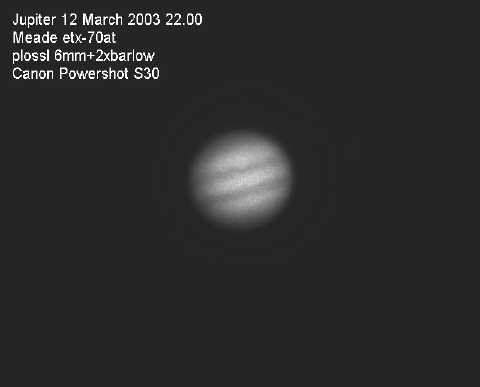
Subject: ETX105 Jupiter Pic Sent: Wednesday, March 19, 2003 2:45:37 From: DAVID_MANN@SIMONSGROUP.COM Here's a Picture of Jupiter that I took with my New ETX105 last night from my back garden in Lincolnshire UK at around 8:15pm. It just about shows the GRS and Io, Europa and Ganymeade. Callisto was just out of shot on the right. Details as below. Scope ETX105ex Alt/Az easy aligned 20mm SMA eyepiece with 2x Shorty barlow. Camera Canon Powershot S30 Mounted on an Orion Steady pix universal camera mount Shutter Speed 0.6secs 3x Optical Zoom White Balance Auto Manual focus set to infinity Processing Paint Shop Pro - Adjust brightness and contrast to show more detail on Jupiter and to enhance the moons. Hopefully you will find it worthy of a place in your guest photography section. Regards Dave

Subject: photos Sent: Wednesday, March 19, 2003 15:15:36 From: abest@zoom.co.uk (alb) Heres a couple of photos taken tonight with etx70 & cannon powershot a40 any tips on enhancing Jupiter pic? thanks abest


Mike here: The Moon is slightly overexposed so reducing the exposure in the camera (however you do that with the Powershot) would help. Jupiter looks either out of focus, motion-blurred, underexposed, or all three. Keep the focus the same as with the Moon.
Subject: Help for Newbie with Astrophotography Sent: Tuesday, April 22, 2003 10:25:52 From: vicky@myfiat.co.uk (MY-FIAT) Great site, loads of info found it thru a Yahoo Group, Now to my question, I just purchased an ETX125 mainly for my daughter who is developing a keen interest in astronomy, I am looking into the possibility of using my existing camera for her to use for taking some photographs with the scope, I understand there are several methods available and was wondering which would produce the best results considering the equipment we have. As stated the scope is a standard ETX125, with a good selection of eyepieces (Thanks to the current Meade offer)! My camera is a Canon 10D Digital SLR 6.5Mpixel. As this camera has good long exposure and high ISO Rating (Up to 3200), I am not sure if the best results would be obtained through prime focus, or eyepiece projection, (I am a little concerned about putting a heavy camera on the eyepiece ring), Any advice or pointers you could share would be gratefully received. Regards VictoriaMike here: See the Accessory Reviews - Astrophotography and Helpful Information - Astrophotography pages. And yes, you might have problems with a heavy camera; but a counterweight might help (see Helpful Information - Astrophotography). As to whether you should go for prime focus, afocal, or eyepiece projection will depend upon the object and what magnification you expect to get. Prime focus is like using the telescope as a telephoto lens (a 1900mm in the case of the ETX-125EC). Afocal lets you use an eyepiece to increase the magnification (same as eyepiece projection) but you shoot through the camera lens instead of removing it. In any case you will need the appropriate adapter for the type of photography and for your camera.
Subject: astrophoto help Sent: Tuesday, May 6, 2003 11:13:36 From: marc_windrich@hotmail.com (marcus windrich) I had a question about taking photos with my digital camera, a Canon Powershot S200. I was out the other night, and wanted to image M13 since it happened to be there. I set the focus to infinite, ISO to 400, and the exposure time to 15 seconds. I took 4 or 5 pictures with this setting and they all came out totally black/blank, except for some noise. M13 is a relatively bright object and I thought it would show up. I know it was in the field of view, I checked that several times and it was pretty well focused. Any ideas what I did wrong? Thanks, and thanks for your invaluable site! Marcus WindrichMike here: I am not that familiar with the Powershot but you are correct, you should have been able to image it. Is the f/ratio adjustable? If so, was it fully wide open? When imaging DSOs with digital cameras it helps to keep the object as bright as possible, meaning that you should use a low power eyepiece. Have you tried shooting the Moon (good target right now)? Practice on it, then move to Jupiter (well positioned right now). Once you know your setup and technique works with the brighter objects, you can move to the more challenging ones.
Subject: Astrophotography with Canon A70? Sent: Tuesday, May 20, 2003 06:51:39 From: araphael@tsn.ca (Alan Raphael) Great site! Thanks for all your hard work! I am interested in getting into astrophotography with my ETX-90EC UHTC but have yet to purchase a digital camera. One I am seriously looking at is the Canon A70 that is a 3MP camera that can handle exposures up to 15 seconds in length. I have looked through your site but can't find any references to someone using that camera. Are you aware of anything positive/negative with it or know of anyone who has used it? Many thanks! Alan RaphaelMike here: Longer exposures might be nice, depending upon how you plan to use it. But in general, almost any digital camera can take nice astrophotographs of many objects, especially the brighter ones. If the camera can accept a remote release cable (or has a self-timer) you will avoid inducing vibrations from pressing the shutter button. If the camera has a built-in noise reduction mode, that can come in handy. If you can manual adjust the exposure settings, that is good. Also, you would like to be able to use one of the adapters to attach the camera to the eyepiece so you want to be certain you can get an adapter that works (which is usually the case if the camera lens accepts standard sized filters).
Subject: Canon Astrophoto for your site Sent: Wednesday, June 25, 2003 12:59:44 From: orion98@tds.net (Greg Sellek) I came across your web site while searching for some Canon digital imaging tips and thought I might pass along a recent image I took using my Canon 10D. Image details are as follows. 12x5 minute exposures w/ Canon 10D set at ISO800 Tak Sky 90 scope, piggybacked on an LX200 Thanks for looking, Greg

Subject: Adapter for Canon A-70 Sent: Tuesday, July 8, 2003 19:44:08 From: pcampbell@vzavenue.net (Philip Campbell) I have an ETX-90 and want to adapt my digital camera to it so I can do prime focus astrophotography. I have a Canon A-70 and the Canon LA-D52C conversion adapter ring. Here is a link to both the camera and adapter rings web site: Camera - http://www.powershot.com/powershot2/a70-60/index.html Adapter ring - www.canoncompanystore.com/cgi-bin/annex.storefront?ProductDetail =848 5A001AA&CategoryNo=1734 The adapter ring gives me the option to remove the ring around the lens of the camera and connect it so one could use other options that Canon sells. The inside threads at the end of the adapter ring is 52mm and it sticks out far enough so one can run the lens in and out. I know that I will need the T-Adapter #64 from Meade. What else do you think I would need to do both prime focus astrophotography and also use an eyepiece at prime focus? Thank you so much for your help. Philip CampbellMike here: If the camera lens is not removable you will not be able to do prime focus photography (so the T-Adapter will be of no use). For afocal photography (shooting through an eyepiece) see the Accessory Reviews - Astrophotography page. The Scopetronix Digi-T System sounds like what you would want, assuming Scopetronix has an adapter for your camera.
Subject: RE: Adapter for Canon A-70 Sent: Saturday, July 12, 2003 07:09:24 From: pcampbell@vzavenue.net (Philip Campbell) Thanks Mike. I had already ordered the Meade adapter for the back of my etx. I think more research is in line for me. You have the best web site thanks for your response and making your site available to us. Phil
Subject: ETX-90 with Canon Ixus 330 digital Camera, can they be mounted together ?? Sent: Monday, July 14, 2003 05:58:11 From: BStenstrom@stockholm.sema.slb.com (Bertil Stenstrm) Started to play with my digital camera Ixus 330. Holding it to my ETX eyepiece gave some decent results with the last solar eclipse. I'm thinking night-photography now. Do you have any idea if the camera can be attached somehow to the eye-pice (I mean not just piggyback) ? Thanks /BertilMike here: I'm not familiar with that camera but if it has a tripod mount hole then you can certainly use on the adapters shown on the Accessory Review - Astrophotography page. If the camera accepts screw-on filters over the lens you might be able to use the Scopetronix Digi-T System (also on the Accessory Reviews page).
Subject: ETX 90RA Astro Shots with a Canon G3 Sent: Wednesday, August 13, 2003 14:25:23 From: pwp1964@sbcglobal.net (Paul) i forgot to share with you the link to my small gallery of ETX 90RA shots that i have taken with my Canon G3 attached with a Scopetronix MaxView 40 eyepiece. i have only had this setup for about a month but so far i really like it! http://www.pbase.com/sdpaul/etx_astro_telescope_g3 thanks again for all of the help you provide to us fellow ETX owners! Paul
Subject: Canon adapter Sent: Wednesday, August 20, 2003 17:39:56 From: peabobb@yahoo.com (Bryan Peabody) I'm interested in exploring digital photography and came across your site. I currently have a Canon A40. I'd be grateful if you could point me in the right direction as to what you would suggest to connect my scope to my digital camera? Thanks in advance. BryanMike here: Check out the Scopetronic Digi-T System; see the Accessory Reviews - Astrophotography page.
Subject: Attaching a G3 to an ETX-125 Sent: Sunday, September 7, 2003 15:54:18 From: maskedman@get2net.dk (Thomas Hjortevang) Thanks for a great site, really a great source of information, keep up the good work! My question is: I invested in a MaxView40 eyepiece + adapter for my Canon G3 for doing astrophotography. Can the ETX-125 handle the weight of the Canon G3 while tracking and me using the handcontroller ? The G3 weighs approx. 14.5 oz./410g. Thanks! Best regards, ThomasMike here: See the Helpful Information - Astrophotography - Canon digital camera page; someone else uses the G3 with an ETX-90RA. So you should be OK.
Subject: Jupiter and Saturn Sent: Saturday, October 11, 2003 16:18:31 From: leutloffa@juno.com (Alan H Leutloff) Stayed up all night and early morning taking numerous shots of Jupiter and Saturn. All shots taken with ETX 90-M and Canon A70 digital camera on separate tripod adjacent to scope. The moons of Jupiter are tough to capturre and require a longer exposure (here set on manual with 1/8th sec exposure...and f=2.8-here even very faint)....hence the washout on Jupiter. Both Jupiter and Saturn pics taken with Orion zoom lense (set at 10mm) and a 2x barlow. Just put in order for a ETX 125 so look forward to more astrophotography adventures soon. Alan



And:
Here's a nice shot of the "hunter" moon taken this weekend...Shot taken with a Canon A70 digital camera on a tripod setup with my ETX 90-M...26mm and 2x barlow lense.

Subject: New ETX 125 Sent: Sunday, October 19, 2003 09:49:37 From: leutloffa@juno.com (Alan H Leutloff) Just unpacked my new ETX 125..and stayed up most the night enjoying the views. Here is a shot of Saturn taken with my Canon A70 digital camera set on a tripod thru the eyepiece. (Its one of my best pics to date of Saturn). Any tips on what pic stacking program is effective? I have downloaded Astrostack but can only load one pic (in JPEG format). What do you recommend? Thanks, Alan

Mike here: Astrostack and Registrax are both effective but I use Keith's Image Stacker since I use a Macintosh. See the Helpful Information - Astrophotography page for some more info on processing images.
Subject: Moon and ETX 125 Sent: Tuesday, October 21, 2003 17:24:23 From: leutloffa@juno.com (Alan H Leutloff) Here is a great shot taken with my recently purchased ETX 125. Really happy with the optics on this scope. Shot taken with a Canon Digital A70 camera mounted on a tripod thru the eyepiece. Craters identified by the free software program "Virtual Atlas of the Moon" at: http://www.astrosurf.com/avl/UK_index.html Great program. Thanks for all the great tips in your website. Alan

Subject: Venus Sent: Tuesday, October 21, 2003 20:15:30 From: leutloffa@juno.com (Alan H Leutloff) here's my first shot of Venus taken this evening (10-21-03) with my ETX 90-M. I used a Canon A70 held to eyepiece...action setting....and an Orion Zoom with 2x Barlow. Alan

Subject: Meade ETX -60 and Canon 300D digital.. Sent: Tuesday, November 11, 2003 13:43:29 From: n2qxf@warwick.net (N2QXF) frustration setting in (grin)... After much searching I cannot find much data on the etx60 and Lunar photography.. I made the 'mistake' of taking some pics of the eclipse with my 300d this weekend and I am hooked...I used a 300MM sigma lens with 1.7 TC..they came OK...but I want larger and better resolution.... webusers.warwick.net/~u1019021/moon.jpg webusers.warwick.net/~u1019021/1600_10_400_714pm.jpg webusers.warwick.net/~u1019021/1600_5.6_8_813pm.jpg webusers.warwick.net/~u1019021/800_10_400_713pm.jpg I am hoping to do variable projection but no one can tell me if the me varibale extension tube and the 9mm or 25mm lens will come into focus on my canon slr... This is my last stop before I forget the idea of ever doing it at all... help! Thanks NickMike here: Yes, astrophotography can be additive. As to those eyepieces and the extension tube, I can't say but you can easily test but holding the eyepiece over each eyepiece and seeing where the focal plane is and see if that distance is too great or too short for your SLR.
Subject: Basic astrophotography Sent: Saturday, November 22, 2003 23:36:19 From: pjr59@earthlink.net It has been several years since I last e-mailed you but I always enjoy your site. I got a digital camera (Canon A80) this month and I tried to take several photos of Saturn using the ETX 90 with afocal photography just holding the camera to the lens. Because I was afraid of camera shake, I never slowed the shutter past 1/30 second. The pictures were 100% totally black, although I had a very nice shot of Saturn in the eyepiece. Do you think this can entirely be due to too fast a shutter speed? Next weekend I plan on trying again with a tripod for the camera with the shutter much slower. PaulMike here: Could be a couple of reasons. Depending upon the "speed" of the ISO setting, 1/30sec could have been too short. Also, if the camera was not pointed directly into the eyepiece the object might not have been visible to the camera. If it wasn't visible on the display then the camera didn't see it. There are attachments you can buy or make that will give you better results. See the Helpful Information - Astrophotography page as well as the Accessory Reviews - Astrophotography page.
Subject: Constellation Photos Sent: Monday, November 24, 2003 19:10:43 From: fishonkevin@sbcglobal.net (kevin keyes) I was testing my new Canon Digital Rebel and took these constellations. I didn't have my ETX-125 with me so there is no tracking. All 3 were taken in manual mode with the shutter on Bulb( using the RS-60E3 cable release), and the camera at F/4. i used the standard 18-55mm lens at 18mm. The only post-processing was to re-size in PSP. Canus Major 99sec. Big Dipper 108 sec. Orion 124 sec. I think they turned out very well, considering no tracking. I can't wait to piggyback it or shoot some prime focus. Kevin



Subject: Moon Sent: Saturday, November 29, 2003 19:38:38 From: leutloffa@juno.com (Alan H Leutloff) Hi Mike and Happy Holidays...took this shot this evening with my ETX 90 and Canon A70 digital. It's one of the "clearest" shots I have taken so far. Learning lots from the Yahoo Group digital_astro. The pic was taken in video mode on the Canon for 10 seconds (and 143 frames) Then AVI file was decompressed and edited using VideoDub (a freeware program designed to allow editing of video from the Canon A70). Registax was then used to select the best frames and the final pic was stacked using 21 of the 143 frames. Your site has been a great learning place. It's only too bad I have to work too to support this exciting hobby of astrophotography!! Alan

Subject: astrophotography Sent: Monday, December 1, 2003 20:36:00 From: pjr59@earthlink.net I wrote a week ago that I was having trouble getting a good shot of Saturn with my ETX90 and my digital camera (Canon A80). Thanks for your suggestions. Before trying Saturn again I tried taking photos of the moon-- I thought it my be easier and give me some practice with the camera. Enclosed is one of the shots using the camera on a tripod near the eyepiece, cropped and darkened a bit but otherwise unaltered. Thanks for your help. Paul

Subject: New Moon Pic Sent: Monday, December 1, 2003 22:09:19 From: leutloffa@juno.com (Alan H Leutloff) Just received my $99 Meade Special Eyepieces...so had to run outside (25 degree's out) and try them out. Here is my first pic of the moon taken with my Canon A70 digital camera. This shot is as is...ie not reprocessed or stacked (one of my best so far I believe) I'm really pleased with the quality of the optics. Can't wait for a warmer night to try them out on my ETX 125.

Subject: Focal Reducer For Canon Digital Rebel Date: Sun, 28 Dec 2003 17:36:52 -0800 (PST) From: Mr Bill ciabattoni (bciabattoni@yahoo.com) I just recently purchased the new digital rebel and would like to try it on some DOS. I have an ETX-125 and wondering if anyone makes a focal reducer that can be used with the t-adapter and an SLR on this scope. Thanks -BillMike here: Since it takes the same lens as the 35mm Rebel camera I would suspect the same T-Ring Adapters would work.
And:
I'm new at this so I maybe my first e-mail wasn't stated correctly. What I'm looking for is something similar to the scopetronix field doubler that will reduce the focal length on my ETX-125 to f7, but can be attached to my t-adapter and SLR. It looks to me that the scopetronix field doubler can only be used with a ccd imager or webcam, not for prime focus SLR photography. Do you know if anyone makes something like this? Thanks -BillMike here: The Shutan Wide Field Adapter will do this. See the Accessory Reviews - Showcase Products page. Since it normally uses an eyepiece, you will need an adapter that connects to 1.25" tube.
Subject: ETX 70 question: Date: 12/29/03, 11:13 From: "Laluna, Robert (NIH/NIDA)" (rlaluna@nida.nih.gov) Just received my ETX 70 for Xmas..Is there any way to attach a digital video camera to it? I have a Canon Optura 20, digital video camera, and was hoping to take some video of images "out there" Thanks..Great site!!! Bobby LaLuna NIH/NIDA Information Resource Management BranchMike here: See the Helpful Information - Astrophotography page for info on digital cameras. See the Accessory Reviews - Astrophotography for some adapters. HOWEVER, you can even shoot photos of brighter objects (Moon, Jupiter, and Saturn) by just holding the camera lens over the eyepiece. Focus the eyepiece to your eye and the camera lens to infinity. Try various camera settings and don't forget that DELETE button! Have fun!
And:
Thanks Mike......Again, Great service from your site as well!!!
Subject: For Guest Astro Deep Sky Gallery Date: 12/29/03, 21:42 From: Paul (pwp1964@sbcglobal.net) Got out last night and tried for the very first time to both see and photograph The Orion Nebula (M42). And it worked pretty well. It would have worked even better had I been able to get the tracking working properly but I think the weight of my equipment and the altitude and angle of Orion at that time caused some slippage with my ETX 90RA (which is understandable). Anyways, this is a stack of 8 images that I did with Registax 2. shot with my Canon G3 at F2 and 1 second shutter speed and at 400 ISO. I shot through a Scopetronix 40mm eyepiece.

And:
I shot Saturn again on 12/27 and the seeing was quite good following our recent storms. The 5x Powermate did not work out too well (big, but poorly resolved), but I was able to get some very nice shots using my Meade 2x Barlow and Scopetronix 40mm eyepiece. I used the Canon G3 at 4x optical zoom, F3, and shutter speeds from between to 5/10 of a second. I stacked and processed 15 of my best images in Registax 2. I am also including a stack of 22 images that were taken with the 5x Powermate for comparison so you can see how much bigger Saturn does appear when using it.


And:
Here is a shot of Venus with the ETX 90RA. It is only about 13 arc secs in size now so the real show with it wont commence till early May when it will appear even larger than Jupiter but in a crescent phase. I believe it is about 83% illuminated now. This is a stack of 36 images done in Registax 2. the camera is the Canon G3 at 4x optical zoom, F3 and shutter speeds of between 1/100 1/200. I used the 2x Barlow and Scopetronix MaxView 40. Paul

Return to the top of this page.
Go back to the Astrophotography Page.
Go back to my ETX Home Page.